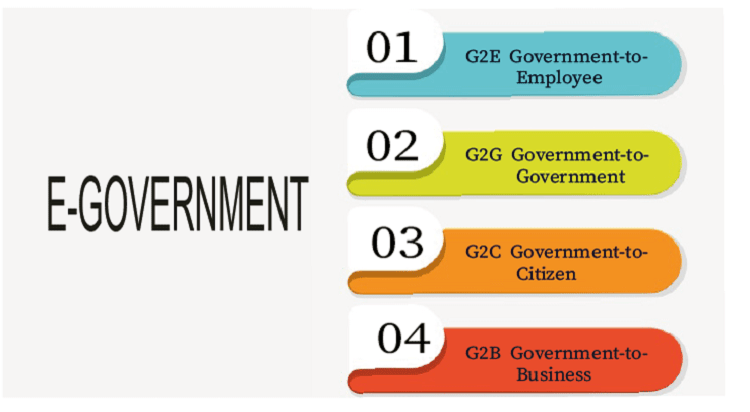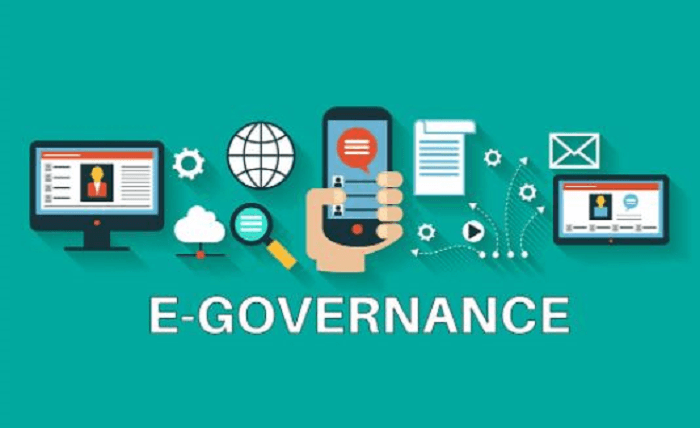Advantages and Disadvantages of E-Governance
The use of information and communication technology (ICT) for government services, information sharing, transactions, and integration of already-existing services and information portals is called e-Governance.

"Electronic" is what the "e" in "e-Governance" stands for. The decision to use e-Governance was made mostly due to the complexity of governance and the rising demands of the public.
E-governance in India
The national satellite-based computer network, NICNET, was launched in India in 1987, providing the primary thrust for e-Governance. The District Information System of the National Informatics Centre (DISNIC) initiative, which supplied free hardware and software to the State Governments, was then introduced as a means of digitalizing all district offices across the nation. By 1990, NICNET had been extended to every district headquarters via the State capitals.
Government Interactions Using E-Government Types

There are four different ways to interact with the government:
- G2G- (Government to Government) is a concept that strives to facilitate information sharing between Governments. Examples include the exchange of government documents and information between the police departments of various States.
- G2C (Government to Citizen) is a concept that strives to facilitate information exchange between the government and its constituents. Examples include online complaint filing, online water and energy bill paying, and more.
- G2B (Government to Business) is a concept that tries to facilitate information exchange between the public and commercial sectors. Examples include sharing laws and data, tax collection, and company patent clearance.
- G2E (Government to Employees) is a concept that intends to share information between the government and its workers, allowing workers to complete various forms online.
E-Governance's Importance
The 21st Century requires e-governance for several reasons, including:
- Normal government is pricy, expensive, and unsustainable from an environmental standpoint. However, the entire carbon footprint of paper has decreased thanks to e-government and the transportation expenses associated with providing essential public services.
- Since it guarantees strong open-source accountability and transparency and enables individuals to easily register their complaints and review the quality of government services, e-government is more democratic and participatory. It allows individuals to learn more about government agencies and participate in decision-making. For instance, registering complaints on the CM Portal enables individuals to guarantee that public services are provided without delay.
- Since technology makes laws and regulations more convenient, e-government promotes better adherence to the law. It is simpler to submit a document with a photo attached than it is to visit the closest government agency and have the application form verified.
- Consequently, e-governance is a ground-breaking way to improve the delivery of government services, make it easier for individuals to fulfil legal requirements, increase public trust and involvement, and decrease fraud.
Objectives of E-Governance

The major objectives of electronic governance are:
- Enhancements to the delivery of services to residents.
- Information delivery is simple.
- Boost coordination between states or between the central and states.
- Boost communication with companies and various sectors.B
- Bringing accountability and openness to governmental issues.
Different e-Governance Projects
- Smart Government: It includes digital files rather than paper ones. Its main focuses are operations simplification, information management, and process automation. It is used at the Secretariat of Andhra Pradesh.
- Khajane Project: The Karnataka government is investing in the Khajane Project. The initiative led to digitalizing the State Government's whole treasury data. Some notable outcomes include reducing the number of drawing officers from 40.000 to about 21,000, training roughly 2000 employees in the use of the software, eliminating 200 positions in the Treasury Department, and so on.
- Digital India Program: The Department of Electronics & Information Technology launched this project. The program sought to empower the nation by advancing its digital infrastructure. Up till 2018, the program's various phases of implementation were completed. Overall, 12,000 remote post offices have been electronically linked due to the agenda.
- E-Kranti Scheme: It is aimed to bring computers, cell phones, and the Internet to remote locations. The program includes setting up IT-related jobs in rural areas and connecting the country's distant communities to the Internet. The e-Kranti scheme consists of 44 Mission Mode Projects.
- E-government in municipalities: It is a project carried out under the jurisdiction of the Jawaharlal Nehru National Urban Renewal Mission and the National e-Governance Plan. The initiative aims to improve the efficiency with which Urban Local Bodies operate. According to NeGP, the State Wide Area Network, State Data Center, Common Service Center, and Service Delivery Gateway are the four infrastructure pillars the government has chosen to implement e-governance.
- Public Distribution System: PDS included automated fair pricing shops, grievance redressal, mechanized food grain storage, transportation, etc.
- E-Panchayats: Since the Panchayati Raj Institutions have not been greatly impacted by the e-governance revolution, the computerization of panchayats is done on a mission-mode basis. The Ministry of Panchayati Raj, Government of India, launched the e-governance project known as e-panchayats to improve the standard of governance in Panchayati Raj Institutions, including 6094 Block Panchayats & 633 Zilla Panchayats.
- Digi-Locker: Under the framework of Digital India, the Indian government launched a plan called Digi-Locker. The initiative's key goals are to go paperless & ensure the security of papers that can be easily accessible from any location and at any time. Important records may be digitally kept in Digi-locker, including Aadhaar cards, transcripts of documents, and certifications. Utilizing Digi-Locker fundamentally requires having an Aadhaar number. The Digi Locker had 20.13 lakh users in 2016.
Challenges in e-Governance
- Trust: People should have faith in the government and feel at ease and confident using the tools and technologies that are available to them. But because of cybercrimes and other causes, public trust is eroded, contributing to the restricted usage of e-governance.
- Digital divide: The term "digital divide" describes the gap between individuals with access to computer technology and those who do not. One of the key factors contributing to the digital gap is economic poverty, and computers are out of reach for most people.
- Lack of awareness: The limited adoption of e-governance methods is partly a result of the utilization of digital technologies. People rely on intermediaries to use e-governance because they are unaware of its full potential.
- Cost: In a developing nation like India, cost significantly impacts how widely e-governance is used.
- Privacy and Security: People are concerned about the confidentiality and security of their personal information, and government should make sure that there are no compromises made toward that goal.
- Accessibility: People cannot use e-governance due to limited infrastructural facilities in remote regions and linguistic obstacles.
- Low Computer Literacy: In India, digital illiteracy is around 90%. One of the main problems is that between 25% and 30% of the population is illiterate.
- Resistance to Change: Although the introduction of information technology has brought about many changes, there are still many officials, people, & politicians who are opposed to change and have differing views on e-Government.
Future of E-Governance
In India, e-Governance is growing steadily, but there are still significant problems to be solved regarding public awareness and the digital divide. E-potential governments can be seen as:
- With the emergence of cryptocurrencies and blockchain technology, India will see a greater demand for e-governance due to the growth of digital platforms and the country's digital economy.
- It's important to safeguard citizens' private information if we want to develop a culture of digital trust, which includes transparency, security, and privacy.
- By ensuring that individuals are equipped with the necessary skills and capacities via digital literacy camps, communication channels, and certificate programs, all of the advantages of e-governance may be realized.
Advantages of e-Governance
- Technologies have quickened and improved communication between businesses and governments. With digital information, there is no need to wait for physical documents to be sent from one location to another, and it is simple and convenient to use.
- Communication is accelerated by technology. High amounts of data may now be instantly transmitted around the globe thanks to the Internet and cell phones.
- Cheaper, more effective, and speedy communications.
- By reducing the expenses of stationary management of paper documents, labour, etc., the usage of ICT reduces transmission costs.
- A high level of openness is ensured through the online publication of all government policies, laws, information, and data, eliminating all administrative impulses to hide information.
- The major demand of citizens for greater governance is for all government procedures to be transparent since this immediately increases administrative transparency.
Disadvantage of E-Governance
- The lack of interpersonal communication is the fundamental drawback of electronic governance. Many individuals believe that interpersonal communication is an essential component of communication.
- Moving paper and documents across the country into the electronic medium is a difficult task in and of itself, especially in a big country like India or China. The government will also need a lot of resources to store and retrieve transaction history.
- A significant investment in expensive infrastructure is required to set up an effective e-governance system in a developing country. To handle massive volumes of information & cyber threats, all public sector organizations at all levels will require servers and computer systems that can connect to the Internet.
- Websites for e-governance are vulnerable to malware and hacker assaults, and they put people's private information, like name, age, residence, bank information, etc., at risk. Governmental organizations must defend their systems against sophisticated online attacks.
- Like many technology-based businesses, E-governance is subject to technical issues such as device failure, power outages, unresponsive or no connectivity, etc. The adoption of e-governance may be constrained by user literacy and computer skills.
- The system removes the interpersonal communication that many individuals appreciate.
|



 For Videos Join Our Youtube Channel: Join Now
For Videos Join Our Youtube Channel: Join Now










